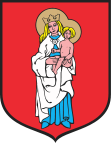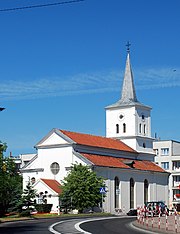Sztum
| Sztum | ||
|---|---|---|

|
|
|
| Basic data | ||
| State : | Poland | |
| Voivodeship : | Pomerania | |
| Powiat : | Sztum | |
| Gmina : | Sztum | |
| Area : | 4.59 km² | |
| Geographic location : | 53 ° 55 ' N , 19 ° 2' E | |
| Residents : | 10,218 (Dec. 31, 2016) | |
| Postal code : | 82-400 | |
| Telephone code : | (+48) 55 | |
| License plate : | GSZ | |
| Economy and Transport | ||
| Street : |
DK 55 : Nowy Dwór Gdański - Malbork - Kwidzyn - Grudziądz - Stolno |
|
|
Ext. 516 : Stacja kolejowa Sztum– DK 55 |
||
| Ext. 517 : Sztum – Tropy Sztumskie | ||
| Rail route : | PKP - route 207: Toruń – Malbork | |
| PKP route 9: Warsaw – Gdansk | ||
| Next international airport : | Danzig | |
Sztum ( German : Stuhm ) is a town with about 10,000 inhabitants in the Polish Pomeranian Voivodeship . It is the administrative seat of the Powiat Sztum and the town-and-country municipality of the same name .
Geographical location
The small town is located in the former West Prussia , about ten kilometers south of Malbork (Marienburg) and twenty kilometers north of Kwidzyn (Marienwerder) .
history


The first signs of settlement date back to the time of the Roman Empire . In the early Middle Ages there was a wooden castle of the Baltic Pruzzen here .
When the knights of the Teutonic Order , the Prußenland Christianized, they conquered in 1236 and this castle. After the first Prussian uprising in 1242, the Teutonic Order built a wooden hill fort at this point. After 1270 an order courtyard followed, which together with the fortifications was expanded into a castle. A settlement around the castle developed very slowly. This received city rights in 1416. Until 1466 Stuhm belonged to the Teutonic Order . In 1492 Nicolaus von Zehmen became burgrave of Stuhm and Christburg. Furthermore, Achatius von Zehmen Starost was at Stuhm and Christburg, where he also lived. In 1517 he became sub-chamberlain of Marienburg, in 1531 castellan of Danzig and in 1546 Woywode of Marienburg. After the Polish Reichstag Achaz I. v. Z. had withdrawn all crown property, his sons, the imperial barons Christoph, Achaz II and Fabian II, stormed the Christburg in December 1576. In exchange for a settlement of 24,000 florins to be paid to the Kingdom of Poland, the brothers were finally able to keep Christburg.
From 1467 to 1772 Stuhm belonged to the autonomous Prussian royal part under Polish patronage . The city functioned as the seat of the Stuhmer district within what was then the state of Marienburg, and regional parliamentary sessions were also held here. In 1635, the Stuhmsdorf Treaty between Poland and Sweden was signed in the village of Stuhmsdorf ( Sztumska Wieś ), a little south of Stuhm .
As part of the first division of Poland , Stuhm came to Prussia in 1772 under Frederick II . From 1816 to 1818 the evangelical church was built according to Karl Friedrich Schinkel's plans, under the supervision of the royal Prussian building inspector Salomo Sachs . 1818-1945 the town belonged to Stuhm circle Stuhm in marienwerder the Prussian province of West Prussia. In 1871 the city and Prussia became part of the newly founded German Empire . At the beginning of the 20th century, Stuhm had a Protestant church, a Catholic church, a synagogue and a district court.
After the end of the First World War , the four districts to the right of the Vistula, Marienburg , Marienwerder , Rosenberg and Stuhm, were to decide on their future membership in a referendum in the Marienwerder voting area . In the vote of July 11, 1920, the majority with 2079 votes of the residents refused to join the Second Polish Republic , newly founded in 1918 , and voted for the city to remain with the German Empire. The district of Stuhm with 19.7% (4904 votes) and the city of Stuhm with 26.5% (749 votes) had the highest number of votes for joining Poland in the entire vote.
During the inauguration of the war memorial for the citizens of Stuhm on June 16, 1929, the East Prussian glider world record holder Ferdinand Schulz flew a lap of honor over the market square and crashed his powered airplane. He and his companion Bruno Kaiser were both killed. On June 14, 1931, President Paul von Hindenburg visited the city.
During the time of National Socialism there was a notorious prison and the National Political Education Institute in Stuhm . On the night of November 9th to 10th, 1938, the Stuhmer synagogue was destroyed.
Towards the end of the Second World War , the Stuhmer's peaceful life ended with the collapse of the German Eastern Front in 1944. On January 21 and 22, 1945, streams of refugees passed through the city. Parts of the city's population joined refugee treks moving towards Danzig and Marienburg. On January 25th, Stuhm was occupied by the Red Army without a fight . Fires were set in the city and more than half of the buildings were destroyed.
Soon afterwards, according to the decisions of the Yalta Conference , Stuhm was placed under Polish administration. The German population, if not already fled, was expelled within the next few years . The name of the city remained phonetically the same and was only changed from German to Polish, Sztum .
Demographics
- Population development until 1945
| year | Residents | Remarks |
|---|---|---|
| 1772 | 469 | |
| 1777 | only 427 | |
| 1778 | 526 | in 79 residential buildings |
| 1783 | 509 | in 79 households, about 50% Lutherans and 50% Catholics, the language about 50% German and 50% Poles |
| 1802 | 847 | |
| 1804 | 918 | in 105 households |
| 1810 | 768 | |
| 1816 | 751 | 275 Evangelicals, 379 Catholics and 86 Jews |
| 1821 | 850 | |
| 1831 | 956 | |
| 1864 | 1980 | 724 Protestants and 1,148 Catholics |
| 1871 | 2156 | of which 780 Protestants and 1,220 Catholics (720 Poles ) |
| 1875 | 2145 | |
| 1880 | 2210 | |
| 1890 | 2265 | including 759 Protestants, 1,405 Catholics and 85 Jews |
| 1905 | 2557 | 706 Protestants and 74 Jews |
| 1933 | 6147 | mostly Catholics |
| 1939 | 7374 | |
| 1943 | 7099 |
- Population since 1945
| year | Residents |
|---|---|
| 2006 | 9945 |
traffic
Sztum station is on the Toruń – Malbork railway line . The villages of Sztumska Wieś and Gościszewo have stops on the same railway line, while the Grzępa stop is no longer served. The district of Gronajny has a stop on the Warsaw – Gdańsk railway line .
Gmina Sztum
The town-and-country community of Sztum includes other localities in addition to the town that gives it its name.
Personalities
Sorted by year of birth
- Achatius von Zehmen (around 1485–1565), high official (including Voivode of Marienburg) in the Prussian Royal Share and in the Duchy of Prussia .
- Fabian I. von Dohna (1550–1621), general in the Electorate of the Palatinate and Brandenburg, diplomat and statesman
- Gustav Adolf von Schlemüller (1797–1863), Prussian lieutenant general, adjutant general of Wilhelm I.
- Johannes Szadowski (1834–1914), Catholic theologian
- Robert Assmus (1842–1904), painter
- Heinrich von Donimirski (1844–1918), MdR
- Arthur Müller (1871–1935), entrepreneur and inventor
- Arthur Daehnke (1872–1932), judge and original, the "Great Prophet"
- Emil Stumpp (1886–1941), German painter and caricaturist, political prisoner
- Ferdinand Schulz (1892–1929), the "Icarus of East Prussia", fell to his death in 1929 on the market square.
- Adolf Giele (1929–2002), handball player
- Goetz Oertel (* 1934), science manager in the USA
- Gerhard Exner (1942–2009), paraplegiologist
- Stefan Amzoll (1943–2019), German musicologist, journalist and author
- Anna Dünnebier (* 1944), writer
literature
- Johann Friedrich Goldbeck : Complete topography of the Kingdom of Prussia . Part II, Marienwerder 1789, p. 19, No. 4).
- August Eduard Preuss : Prussian country and folklore or description of Prussia . Bornträger Brothers, Königsberg 1835, pp. 444–445, no. 59.
- Friedrich Wilhelm Ferdinand Schmitt : History of the Stuhmer circle . Thorn 1868, pp. 168-179.
- Isaac Gottfried Gödtke : Church history of the city of Stum . In: Archives for patriotic interests . New series, year 1845, Marienwerder 1845, pp. 619–633.
Web links
Footnotes
- ^ Friedrich Wilhelm Ferdinand Schmitt : History of the Stuhmer circle . Thorn 1868, pp. 168-179.
- ^ Friedrich Wilhelm Ferdinand Schmitt : History of the Stuhmer circle . Thorn 1868, p. 41.
- ↑ a b Meyers Großes Konversations-Lexikon , 6th edition, Volume 8, Leipzig and Vienna 1907, p. 251.
- ↑ Herbert Marzian , Csaba Kenez : self-determination for East Germany. Documentation on the 50th anniversary of the East and West Prussian referendum on July 11, 1920. Editor: Göttinger Arbeitskreis , 1970, p. 124
- ↑ a b c d Friedrich Wilhelm Ferdinand Schmitt : History of the Stuhmer circle . Thorn 1868, p. 178.
- ^ Johann Friedrich Goldbeck : Complete topography of the Kingdom of Prussia . Part II, Marienwerder 1789, p. 19.
- ↑ a b c d Alexander August Mützell and Leopold Krug : New topographical-statistical-geographical dictionary of the Prussian state . Volume 5: T – Z , Halle 1823, pp. 394–395, item 722.
- ^ August Eduard Preuss : Prussian country and folklore . Königsberg 1835, p. 444, no.59.
- ^ E. Jacobson: Topographical-statistical manual for the administrative district Marienwerder . Danzig 1868. List of localities of the Marienwerder administrative district , pp. 202–203, no. 139.
- ^ Gustav Neumann: Geography of the Prussian State . 2nd edition, Volume 2, Berlin 1874, pp. 47-48, item 1.
- ^ A b c d Michael Rademacher: German administrative history from the unification of the empire in 1871 to the reunification in 1990. Stuhm district. (Online material for the dissertation, Osnabrück 2006).
- ↑ Der Große Brockhaus , 15th edition, Volume 18, Leipzig 1934, p. 289.
- ↑ Ernst Bahr: Stuhm , in: Handbook of historical sites, East and West Prussia , Kröner, Stuttgart 1981, ISBN 3-520-31701-X , pp. 216-217.



